Exhibit 99.1
chairman’s address
Chairman’s Address to 2005 Annual Meetings
Check against delivery
My focus today is firmly on James Hardie’s achievements.
I don’t propose to use this Address to re-visit history. I believe we have done that adequately
through my address to you at last year’s meeting, our public statements since then and in this
year’s Annual Report.
I start by paying tribute to the people and products that are James Hardie today. In the face of an
extraordinarily difficult eighteen months, your company’s business has not just survived, it has
continued to grow and prosper. I want to acknowledge this success, and reflect a little on just
what this company is capable of achieving.
Our success is testament to the strength and robustness of this business, and its high-performance
culture.
At every level, from those who develop and manufacture our products, to those who sell them in the
various markets, from those who set the business strategy and guide our overall policy, to those
who support our activities in functional roles, the people who constitute James Hardie have worked
tirelessly to look after those they serve, to achieve the best outcome for the company and all
those who depend on its ongoing success — its stakeholders.
We recognise that we need to regain our place in corporate Australia
In talking about the underlying strength and success of our business, I’m not ignoring the negative
sentiment towards the company, exacerbated by the time it has taken to finalise the voluntary
asbestos compensation funding proposal.
We are working to overcome this, not only by seeking to finalise the voluntary funding
arrangements but also by continuing to further improve our business performance, to support our
employees, and to meet our customers’ needs.
At this point, I thank you, our shareholders, for your continued support of the company and for
your ability to see beyond the headlines, to understand the very real complexities involved in the
asbestos issue and to recognise that your Board is committed to finalising the current negotiations
for a sustainable long-term voluntary funding arrangement.
2005
Chairman’s Address
1
We are working to implement the Heads of Agreement
And we are committed to signing a legally-binding Principal Deed with the NSW Government which
implements in the shortest possible time the Heads of Agreement which the NSW Government, James
Hardie and others signed last December.
We continue to work on resolving the remaining issues, despite the many complexities involved in
developing an arrangement that will still work, as well as providing reasonable protections for the
Fund, over at least a 40+ year period.
In the Annual Report, I expressed the hope that the signing of this Deed would not be far off,
although there were still several significant issues to be resolved. This remains the case today,
although the points of difference are, we hope, narrowing.
In question forms submitted ahead of today’s meeting, holders asked for an update on the timing of
the proposed funding solution being put to them for approval.
Having nominated — and missed — three deadlines already, I’m reluctant to suggest another
definitive timeframe for the conclusion of negotiations. I can say that we are very disappointed
and frustrated it has taken as long as it has and we are working for resolution as soon as
possible. However, this has to be done in the context of ensuring our company remains financially
strong, retains the support of you, our shareholders, and of our lenders and is able to continue to
grow and to fund its growth for the benefit of all stakeholders.
Much has been achieved since we signed the Heads of Agreement
Despite our frustration at not yet being at a point where we can put an agreed proposed funding
arrangement to you, we have achieved or resolved many of the issues identified by your directors as
necessary pre-requisites to seeking your approval for the proposal:
| 1. |
|
We have what we believe is a more stable estimate of the extent of the funding anticipated to
be required. This has come from the KPMG Actuaries reports first released by us in June last
year and updated in March this year, the second of which shows a central estimate of funding
requirement of A$1.685 billion NPV as at 31 March 2005. An updated report to 30 June 2005,
including estimated legal and administrative cost savings, is now around 95% complete. |
| |
| |
|
The voluntary funding arrangement set out in the very detailed Heads of Agreement is intended
to provide for payments to be made to all future proven claimants in Australia against the
former James Hardie subsidiaries for asbestos-related diseases arising from exposure to
asbestos in Australia. |
| |
| |
|
However, it should be recognised that because the factors which affect the liabilities
including the number of claimants and the amounts that the courts may award is uncertain and
James Hardie may not perform as currently projected- no absolute assurance on this can be
given. |
| 2. |
|
The NSW Government has committed to reducing the inefficiencies in the dust diseases claims
system in NSW. According to the KPMG report at 31 March 2005, legal costs were estimated to
be $436 million — around 26% of the A$1.685 billion estimated amount attributable to James
Hardie’s former subsidiaries. |
2005
Chairman’s Address
2
| |
|
The same report estimated that legal costs were at that time running at 35% of the net costs of
settlement1. |
| |
| |
|
To put this into even sharper perspective, KPMG has estimated that system costs could be
costing both plaintiffs and defendants around $2 billion (in today’s dollars) of the estimated
total Australian liability of $8.2 billion. |
| |
| |
|
Our determination over this issue has paid off: The Government agreed to conduct a review of
these costs and completed this review in March this year. The relevant legislation and
regulations that took effect on July 1 implement a number of recommendations of the review that
will help to reduce legal, administrative and other costs — we hope to a considerable extent,
and in a way that is sustainable in the long-term. The Government reforms also require the
collection of accurate cost data which will provide the basis of ongoing reviews, which are
required to ensure the system continues to improve. We commend the Government on these reforms. |
| |
| 3. |
|
Consistent with the stated objectives of all those involved in its negotiations, including
the NSW Government, the regime outlined in the Heads of Agreement seeks to ensure that James
Hardie remains financially successful whilst providing an ongoing funding stream for future
proven Australian asbestos-related personal injury claimants. In practice, that means the
company has the ability to retain enough cash to invest in the business and maintain the
future support of the debt and equity markets which are critical to its financial health and,
hence, its capacity to fund future claims. We are working to ensure this is maintained in the
Principal Deed. |
| |
| 4. |
|
In addition, James Hardie has completed its new debt financing facilities in June and, as a
consequence, has the necessary financial capacity to make the proposed initial funding
payment. |
| |
| 5. |
|
Still in the area of financial considerations, we need to continue to pursue tax
deductibility for voluntary payments to be made by the company. Obtaining deductibility is
critical to the affordability of the proposal for James Hardie and could materially affect its
financial health (which is, in turn, critical to both our shareholders and asbestos claimants
alike). We have been engaged over many months with the Australian Tax Office and the Federal
Treasury to resolve this requirement and remain hopeful that it can be settled for the benefit
of all stakeholders. |
| |
| 6. |
|
Preparation of related agreements, including detailed arrangements to establish a Special
Purpose Fund and support the funding obligations the company is assuming is at an advanced
stage. |
| |
| 7. |
|
Other key requirements, such as: |
| |
• |
|
an Independent Expert’s report and |
| |
| |
• |
|
an Explanatory Memorandum explaining the proposal to shareholders |
are around 80% completed, and — like other reports and documents — are capable of being
finalised in a short time frame as soon as the Principal Deed is finalised.
|
|
|
| 1 |
|
Net costs are costs after insurance recoveries |
2005
Chairman’s Address
3
Following the completion of all the requirements I have outlined, there will be a shareholder
vote at an Extraordinary General Meeting. The details of all of these will be communicated to
you separately.
What is in the Principal Deed?
In summary, your directors are seeking in the Principal Deed an agreed funding mechanism which:
| |
1. |
|
implements the previously agreed Heads of Agreement; |
| |
| |
2. |
|
is consistent with our directors’ duties to the company and its stakeholders; |
| |
| |
3. |
|
provides an agreed and efficient regime to deal with funding proven Australian
personal injury claims for at least 40 years, for the benefit of both shareholders and
claimants under various potential changing circumstances; |
| |
| |
4. |
|
is affordable for the company; and |
| |
| |
5. |
|
retains the support of our lenders. |
The key elements of the agreed funding arrangement, which were set out in the Heads of Agreement,
include:
| |
• |
|
the establishment of a Special Purpose Fund (SPF) to compensate asbestos victims; |
| |
| |
• |
|
initial funding of the SPF by James Hardie on the basis of an Actuaries’ report which is
to be updated annually; |
| |
| |
• |
|
a two year rolling cash ‘buffer’ in the SPF and an annual top up contribution in advance
based on actuarial assessments of expected claims for the next three year period,
recalculated annually; |
| |
| |
• |
|
a cap on the annual James Hardie payments to the SPF, initially set at up to 35% of
annual net operating cash flow of the James Hardie Group for the immediately preceding
financial year, with provision for the percentage to decline over time depending on James
Hardie’s financial performance and the claims outlook; and |
| |
| |
• |
|
no cap on individual payments to proven claimants. |
All these elements have already been satisfactorily reflected in the draft Principal Deed.
The Current State of Negotiations with the NSW Government
What is proving to be challenging is translating from the Heads of Agreement into the Principal
Deed agreed responses to contingencies that may or may not arise over the next 40 years or so.
2005
Chairman’s Address
4
We are currently considering Draft Nine of the Principal Deed, recently prepared by the Government.
Unfortunately, as we advised the market on Wednesday, the Government’s negotiating team sought to
introduce into Draft Nine a number of new matters which were not raised during lengthy face-to-face
meetings between the negotiating teams when Draft Eight was discussed. Further, some matters which
we considered had already been agreed were not reflected in Draft Nine.
We are reviewing these changes carefully in the interests not only of you, our shareholders, but
also current and future claimants who may be depending on the sustainability of these arrangements
for over 40 years into the future.
I can assure you that we are seeking finalisation of these remaining issues as soon as we possibly
can. It is certainly not in our company’s interests for this issue to remain unresolved any longer
than is necessary to secure a fair and sustainable outcome — that is, one which implements the
Heads of Agreement.
I now turn to deal with more usual corporate matters, and I do thank shareholders for their support
while we resolve the outstanding issues with the NSW Government.
We will return to a more structured Dividend policy
A number of holders had questions about our Dividend policy, and I want to comment briefly on that
now.
It is appropriate to discuss dividends in this context, because the issue of Dividend payments is
related to the voluntary asbestos funding.
In the past, James Hardie made semi-annual dividend payments. We did not declare or pay an interim
dividend payment in January 2005, due to the uncertainty surrounding implementation of our
voluntary funding proposal, particularly the legal ability of JHI NV to pay a dividend if it
recorded or knew it might record in its accounts a provision for funding.
This accounting question has since been resolved and the company declared a dividend in May 2005
that included payment of the January interim dividend.
We anticipate that our Dividend policy will now return to semi-annual payments.
A number of holders have also asked about a Dividend Reinvestment Scheme. Whilst we will
periodically revisit this option of raising capital, the company does not have any current plans to
introduce such a scheme.
We have reviewed our Corporate Governance practices
In the public statements I have made about James Hardie in the last year, I have expressed my
belief that our experiences raise some important corporate governance issues about the very real
and complex difficulties directors may face when they attempt to address community expectations
and, at the same time, ensure the company continues to operate successfully and with the ongoing
support of its shareholders for the benefit of all stakeholders.
2005
Chairman’s Address
5
Seeking reassurance about the underlying health of the company’s governance, the Board commissioned
two independent reviews to examine various aspects of the company’s governance practices.
First, even before the release of the findings of the Commission of Inquiry last year, the Board’s
Audit Committee instigated an independent investigation into whether allegations raised during the
inquiry had any impact on the company’s accounts. We were reassured to be advised that the
integrity of our accounting processes remained intact and there was no impact on the accounts.
Second, we commissioned a global review of the company’s approach to corporate governance in each
of the jurisdictions in which we operate. Again, this report reassured us that the policies and
practices we use to guide our decisions and operations are sound and comply with the requirements
of the jurisdictions in which we operate.
In light of recent changes to the Dutch Civil Code and Corporate Governance Code — and consistent
with best practice — we have proposed amendments to our Articles of Association for your approval
at this year’s Annual General Meeting. A number of these amendments are mandatory under Dutch law,
others are best practice under the Code and others are in accordance with the recently ratified
US-Netherlands Tax Treaty. I would be happy to answer questions on these later when we move to the
items covered in the Notice of Meetings.
We are undertaking Board renewal to ensure our ongoing strength
At the last Annual General Meeting, I spoke of a program of Board renewal.
We have, since then, engaged a search firm to help us identify new directors with business
experience in USA and Europe and the personal qualities and values important for contributing to
the balanced composition of this demanding Board.
Our goal is a properly-implemented program of succession that injects new ideas and approaches,
allows for a transition in directors, and ensures the continued stability of your company.
As advised in the Annual Report, and in the notice of meetings, while Greg Clark, Michael Brown and
James Loudon are standing for re-election at this year’s AGM, both Michael and James have indicated
that, if re-elected, they plan to retire from the Board at an appropriate time during their
forthcoming terms, following the appointment of new directors.
Since both are members of the Audit Committee — Michael Brown is its Chairman — and both designated
financial experts under the Sarbanes Oxley Act of 2002, we will be ensuring that their replacements
also possess the requisite financial expertise.
Michael and James have said they’re willing to remain on the Board not just until new directors are
appointed but also for a transition period, which is particularly important in the context of the
Audit Committee.
2005
Chairman’s Address
6
I am confident that we will be able to attract people of the calibre we need, by offering them the
challenges and rewards of being involved with a high growth company in a vast market with an
outstanding product and people, despite the demands of time and travel for this busy global Board.
We are taking the time to conduct the search process properly and we will not be offering to
appoint anyone until we’ve resolved the asbestos funding issue with your approval so that any new
directors have a clear understanding of the company’s commitments before they are asked to agree to
join the Board.
We will also need to secure shareholder approval of enough money to pay them. I foreshadowed in the
Annual Report that we will be seeking your approval for an increase in the Directors’ fee pool to
ensure we can offer a competitive remuneration package, including a higher proportion of shares in
lieu of cash than we currently receive. Your Board does not believe it is appropriate to pursue
such an increase until we have resolved the asbestos funding issue. That is why there is no such
motion put to this year’s AGM. Your Board will nevertheless be seeking to do so at the EGM so we
can proceed to make such appointments when suitable candidates are found.
I would
like to take this opportunity to record my thanks to Mike and James — and indeed to all my
fellow directors — for their support, guidance and counsel over the past year. The company and its
shareholders have been well-served by your passion, and your commitment. Mike in particular has had
a demanding job as Chairman of our Audit Committee and has performed it with great expertise. More
recently James has been chairing our Due Diligence Committee which is overseeing the preparation of
the Explanatory Memorandum for shareholders and has brought wisdom and dedication to this role.
We have the right people in management to guide our growth
When we appointed Louis Gries as the company’s Chief Executive Officer in February, we expressed
our delight at having such a strong and experienced internal candidate for this position.
Louis has a long history of outstanding achievements for James Hardie since he joined us in 1991,
and we have great confidence in his business expertise, his personal integrity and his
forthrightness.
Louis has appointed to the General Management Team a number of outstanding executives whose talents
and values contribute to an already highly-skilled and effective leadership team.
Under their management, the company continues to successfully pursue its strategy of fibre cement
leadership in all the countries in which we operate.
In addition, I commend Russell Chenu, our CFO, who has brought a considered, steady and fair-minded
approach to the negotiations for the Heads of Agreement and who continues to spend almost all his
time in Australia to negotiate a satisfactory Principal Deed.
2005
Chairman’s Address
7
Our business operations are strong
We announced our results for the 2005 Fiscal Year in May. Despite the many challenges we were
facing in Australia, these were very pleasing. They are reflected in the accounts you are
considering today and those in our Annual Report which you have received. This morning, we
announced our results for the first quarter of the 2006 Fiscal Year, and I am pleased to advise
that these are also very good — a 51% increase in operating profit from continuing operations to
US$55.9 million for the three months ended June 30, 2005; a 17% increase in net sales; a 31%
increase in gross profit; and a 49% lift in EBIT.
I will shortly hand over to Louis, who will talk about the business in more detail.
We continue to make a substantial contribution to Australia
All the discussion about James Hardie being a Dutch company ignores the fact that we are a
significant Australian success story, and we continue to make a major contribution to this country.
In 1990, we built our first US plant in Fontana, California in 1990. Today, we have 13 plants in
the US, Australia and the Philippines and our total annual production capacity is 3,425 million
square feet. This will increase to 14 plants and 4,025 square feet when we complete the
construction of our latest plant, in Pulaski Virginia — our largest plant to date.
James Hardie pioneered the development of asbestos-free fibre cement building materials in
Australia and we still have three manufacturing plants and a Research and Development Centre here.
Through our products, we are a major supplier to, and supporter of, the local building industry. We
are also making a contribution to the wider community, both here and overseas, by providing
products and employees’ efforts to the humanitarian organisation, Habitat for Humanity. The taxes
we pay here contribute to the Australian economy.
Conclusion
The final settlement of the voluntary asbestos compensation solution that we are working so hard to
be able to put to you for approval in the coming months is a key milestone for the company. But the
results we have been achieving and continue to achieve today show that your company is by no means
simply marking time in other areas until this happens.
I congratulate management on their focussed dedication, innovation and persistence in
continuing to ensure James Hardie’s business operations are so strong. This will benefit all who
have an interest in your company’s long-lasting success — now, and in the future.
I now invite our CEO, Louis Gries, to talk to you about the business.
2005
Chairman’s Address
8
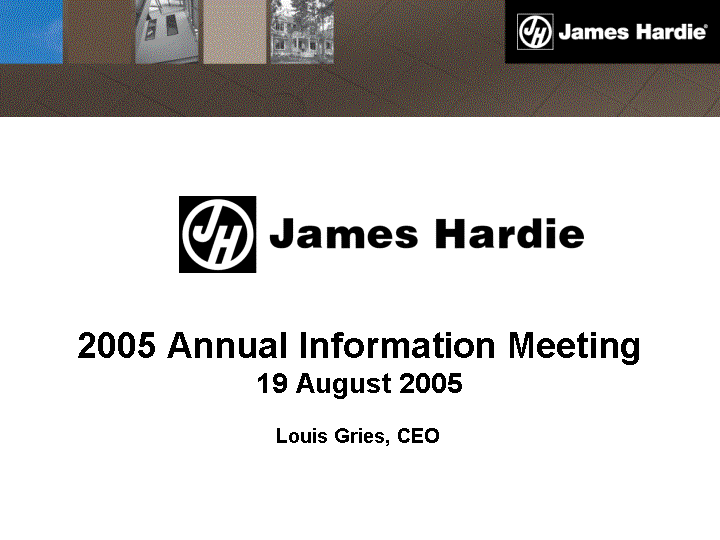
|
2005 Annual Information Meeting
19 August 2005
Louis Gries, CEO
|
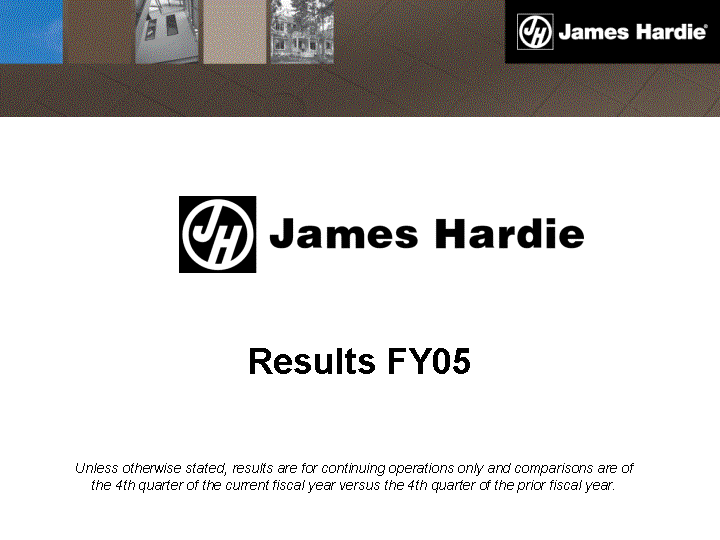
|
Results FY05
Unless otherwise stated, results are for continuing operations only and comparisons are of
the 4th quarter of the current fiscal year versus the 4th quarter of the prior fiscal year.
|

|
Highlights - FY05
Full Year
USA Fibre Cement - EBIT up 24%
Australia and New Zealand Fibre Cement - EBIT up 20%
Philippines Fibre Cement - EBIT more than doubled
Chile Fibre Cement - positive EBIT in all quarters
Hardie Pipe - significant reduction in EBIT loss
|
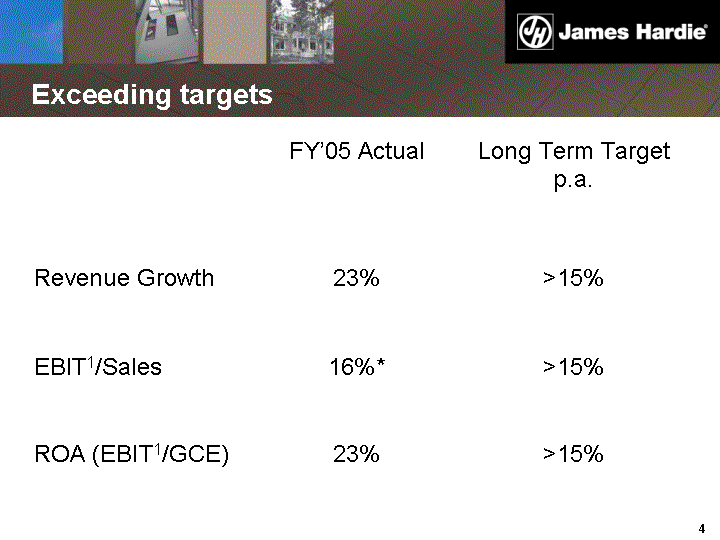
|
Exceeding targets
FY'05 Actual Long Term Target
p.a.
Revenue Growth 23% >15%
EBIT1/Sales 16%* >15%
ROA (EBIT1/GCE) 23% >15%
|
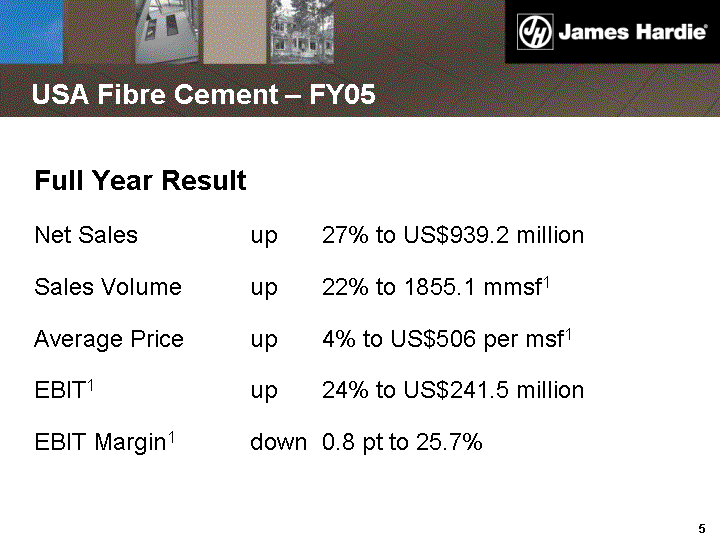
|
USA Fibre Cement - FY05
Full Year Result
Net Sales up 27% to US$939.2 million
Sales Volume up 22% to 1855.1 mmsf1
Average Price up 4% to US$506 per msf1
EBIT1 up 24% to US$241.5 million
EBIT Margin1 down 0.8 pt to 25.7%
|
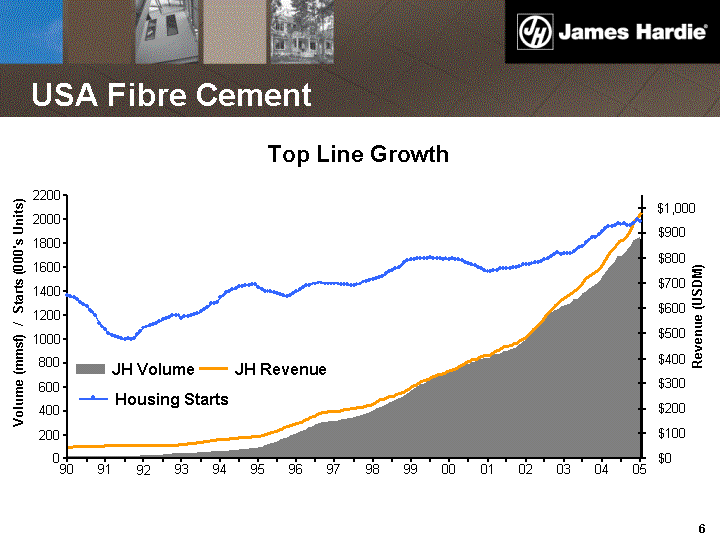
|
USA Fibre Cement
Top Line Growth
Volume (mmsf) / Starts (000's Units)
$1,000
Revenue (USDM)
0
200
400
600
800
1000
1200
1400
1600
1800
2000
2200
90
91
92
93
94
95
96
97
98
99
00
01
02
03
04
05
$0
$100
$200
$300
$400
$500
$600
$700
$800
$900
JH Volume
JH Revenue
Housing Starts
|
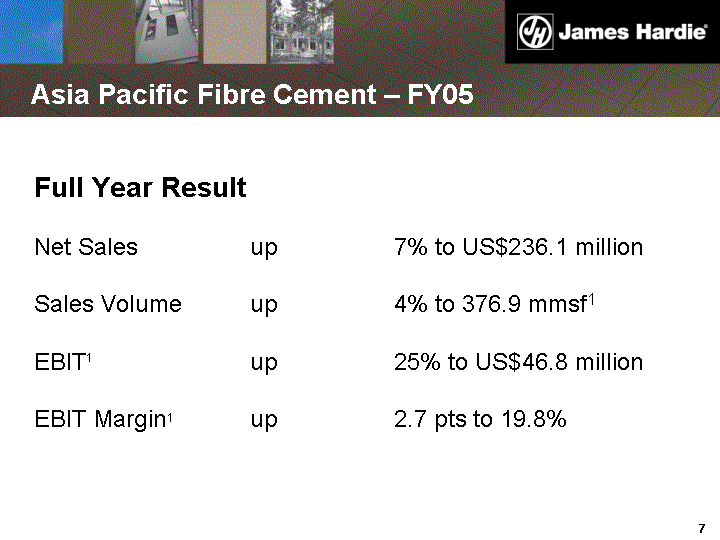
|
Asia Pacific Fibre Cement - FY05
Full Year Result
Net Sales up 7% to US$236.1 million
Sales Volume up 4% to 376.9 mmsf1
EBIT1 up 25% to US$46.8 million
EBIT Margin1 up 2.7 pts to 19.8%
|

|
Results Q1 FY06
Unless otherwise stated, results are for continuing operations only and comparisons are of
the 4th quarter of the current fiscal year versus the 4th quarter of the prior fiscal year.
|
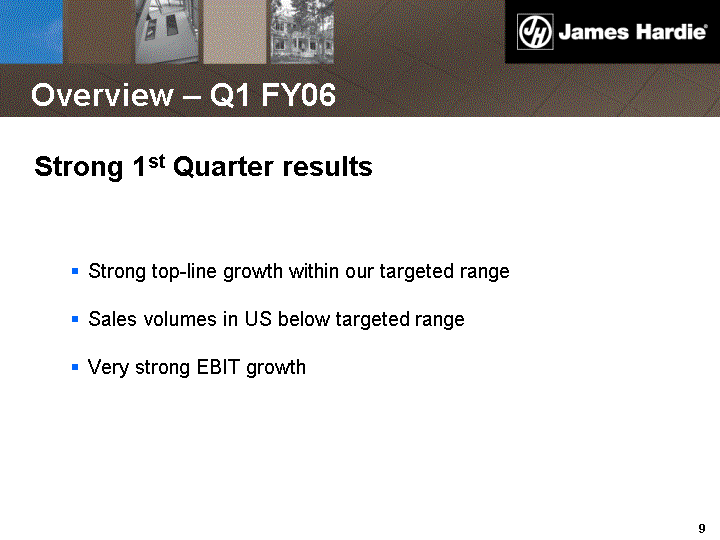
|
Overview - Q1 FY06
Strong 1st Quarter results
Strong top-line growth within our targeted range
Sales volumes in US below targeted range
Very strong EBIT growth
|
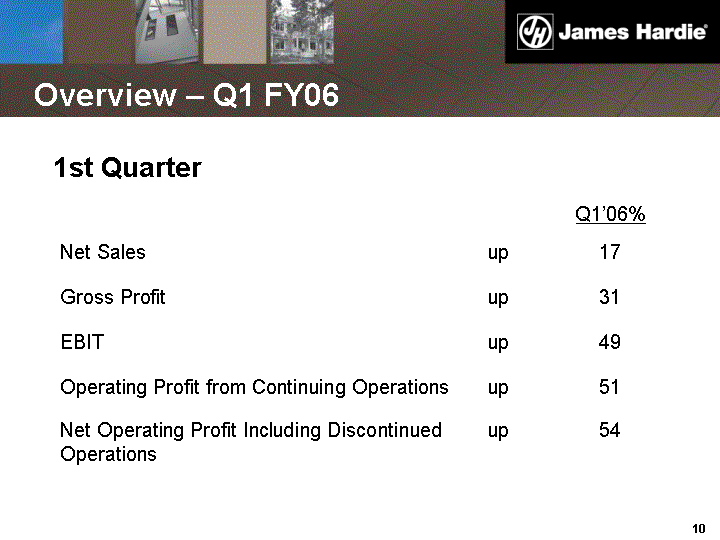
|
Overview - Q1 FY06
1st Quarter
Q1'06%
Net Sales
up 17
Gross Profit up 31
EBIT up 49
Operating Profit from Continuing Operations up 51
Net Operating Profit Including Discontinued Operations up 54
|
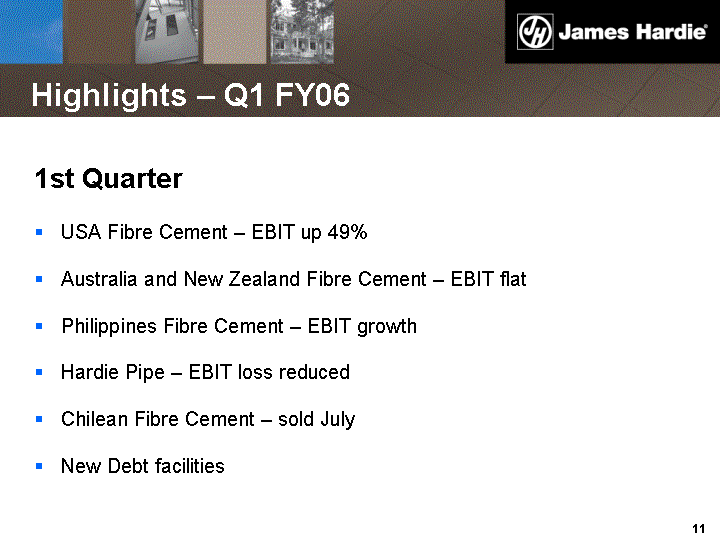
|
Highlights - Q1 FY06
1st Quarter
USA Fibre Cement - EBIT up 49%
Australia and New Zealand Fibre Cement - EBIT flat
Philippines Fibre Cement - EBIT growth
Hardie Pipe - EBIT loss reduced
Chilean Fibre Cement - sold July
New Debt facilities
|
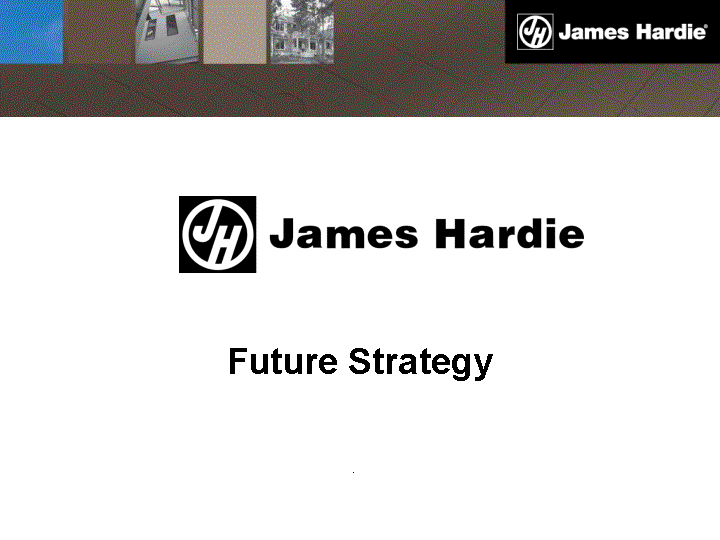
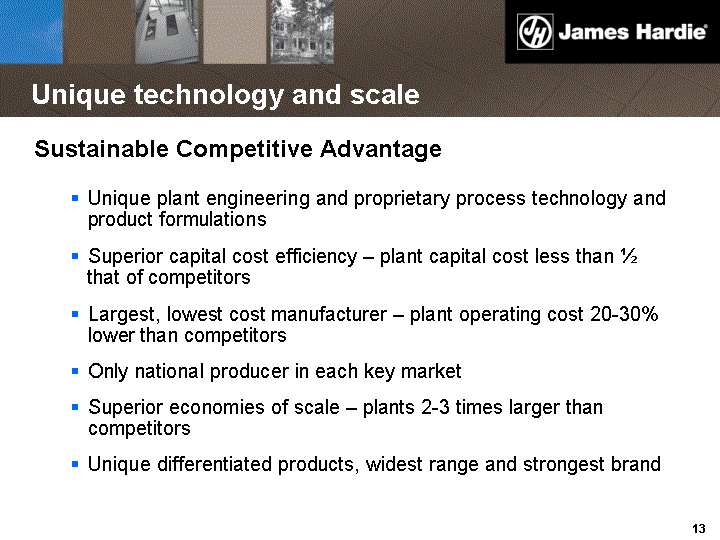
|
Unique technology and scale
Sustainable Competitive Advantage
Unique plant engineering and proprietary process technology and
product formulations
Superior capital cost efficiency - plant capital cost less than 1/2
that of competitors
Largest, lowest cost manufacturer - plant operating cost 20-30%
lower than competitors
Only national producer in each key market
Superior economies of scale - plants 2-3 times larger than
competitors
Unique differentiated products, widest range and strongest brand
|
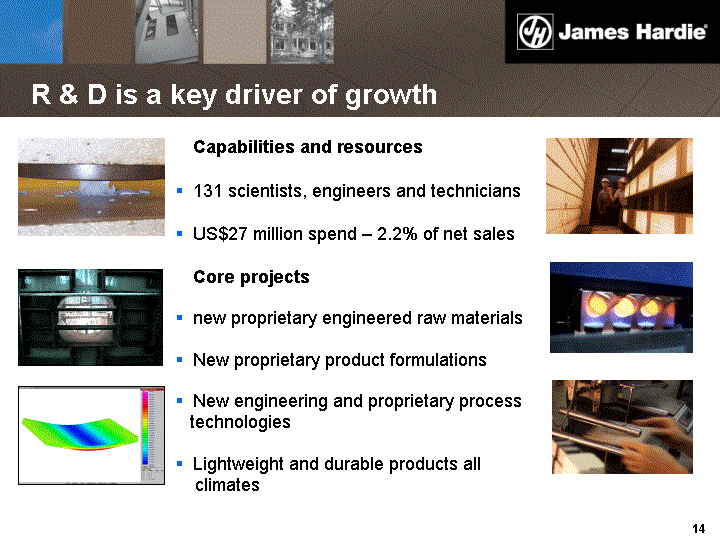
|
R & D is a key driver of growth
Capabilities and resources
131 scientists, engineers and technicians
US$27 million spend - 2.2% of net sales
Core projects
new proprietary engineered raw materials
New proprietary product formulations
New engineering and proprietary process
technologies
Lightweight and durable products all
climates
|
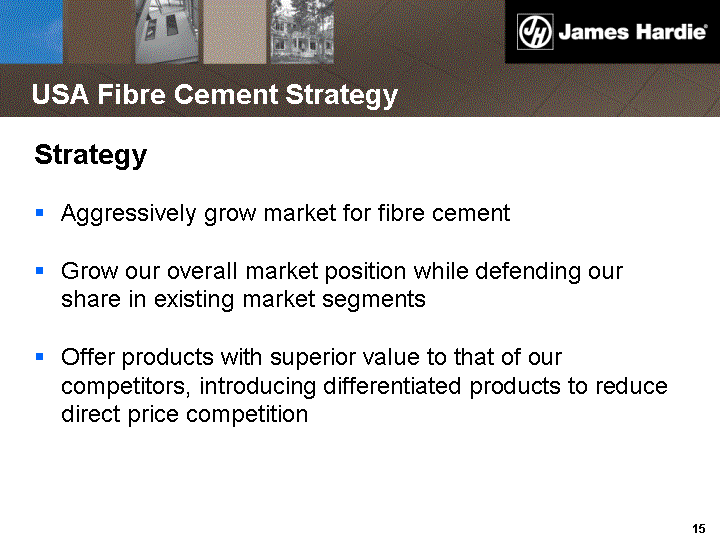
|
USA Fibre Cement Strategy
Strategy
Aggressively grow market for fibre cement
Grow our overall market position while defending our
share in existing market segments
Offer products with superior value to that of our
competitors, introducing differentiated products to reduce
direct price competition
|

|
USA Fibre Cement
James Hardie is the largest lowest cost producer of
fibre cement in North America
Plant Locations
Flat Sheet
Plants Flat Sheet
Plants Capacity (mmsf1)
Fontana, California Fontana, California 180
Plant City, Florida Plant City, Florida 300
Cleburne, Texas Cleburne, Texas 500
Tacoma, Washington Tacoma, Washington 200
Peru, Illinoisb Peru, Illinoisb 560*
Waxahachie, Texas Waxahachie, Texas 360
Blandon, Pennsylvania Blandon, Pennsylvania 200
Summerville, South Carolina Summerville, South Carolina 190
Reno, Nevadaa Reno, Nevadaa 300*
Pulaski, Virginiac Pulaski, Virginiac 600*
Flat Sheet Total Flat Sheet Total 3,390
FRC Pipe Plant FRC Pipe Plant
Plant City, Florida 100,000 tons 100,000 tons
JH Plant Design Capacity
*Upgrade or new plant in progress - include capacity being added.
a. Completion Q4 FY05 - Ramp-up in progress
b. Includes 160 mmsf XLD Trim Line - Being commissioned
c. Construction to commenced in Q4 FY05
Tacoma, WA
Fontana, CA
Plant City, FL
Waxahachie, TX
Cleburne, TX
Peru,, IL
Blandon, PA
Summerville, SC
Pulaski, VA
Reno, NV
New Plant
|

|
Asia Pacific Fibre Cement
Strategy
Grow primary demand for fibre cement
Vigorously protect and grow category share in existing
market segments
Leverage our superior technology to offer differentiated
products and systems with superior value to those of
competitors
|
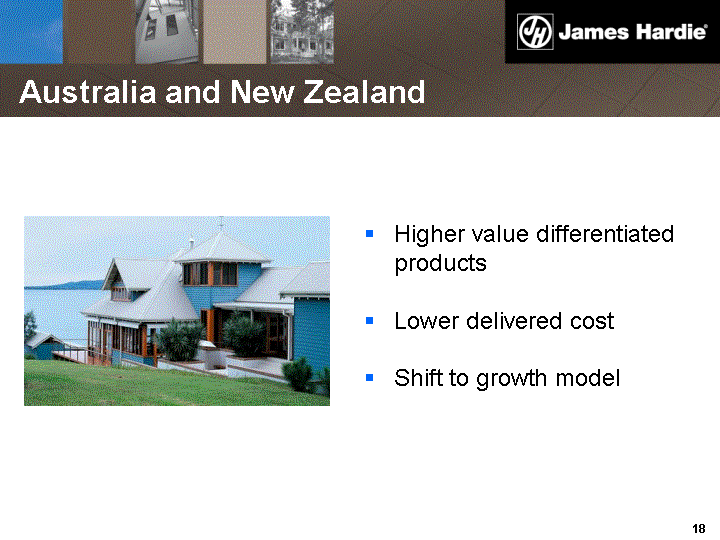
|
Australia and New Zealand
Higher value differentiated
products
Lower delivered cost
Shift to growth model
|
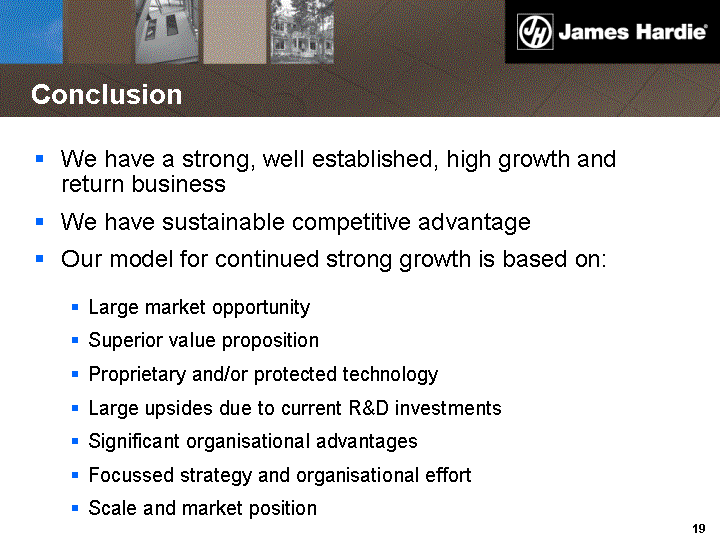
|
Conclusion
We have a strong, well established, high growth and
return business
We have sustainable competitive advantage
Our model for continued strong growth is based on:
Large market opportunity
Superior value proposition
Proprietary and/or protected technology
Large upsides due to current R&D investments
Significant organisational advantages
Focussed strategy and organisational effort
Scale and market position
|
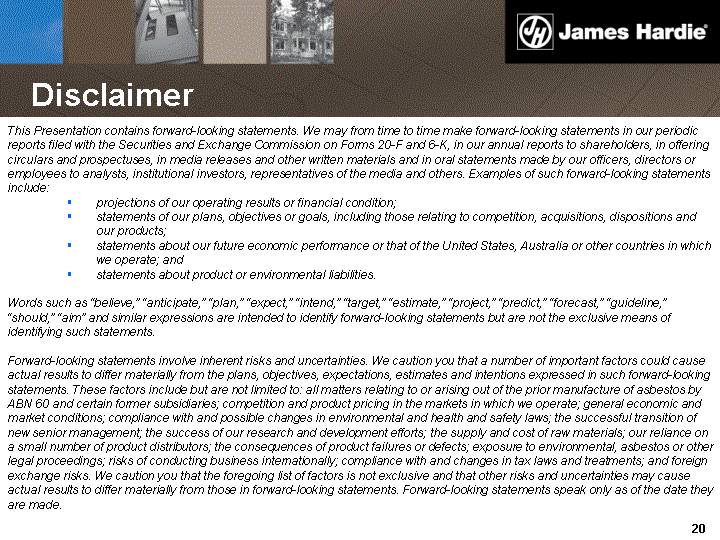
|
Disclaimer
This Presentation contains forward-looking statements. We may from time to time make forward-looking statements in our periodic
reports filed with the Securities and Exchange Commission on Forms 20-F and 6-K, in our annual reports to shareholders, in offering
circulars and prospectuses, in media releases and other written materials and in oral statements made by our officers, directors or
employees to analysts, institutional investors, representatives of the media and others. Examples of such forward-looking statements
include:
projections of our operating results or financial condition;
statements of our plans, objectives or goals, including those relating to competition, acquisitions, dispositions and
our products;
statements about our future economic performance or that of the United States, Australia or other countries in which
we operate; and
statements about product or environmental liabilities.
Words such as "believe," "anticipate," "plan," "expect," "intend," "target," "estimate," "project," "predict," "forecast," "guideline,"
"should," "aim" and similar expressions are intended to identify forward-looking statements but are not the exclusive means of
identifying such statements.
Forward-looking statements involve inherent risks and uncertainties. We caution you that a number of important factors could cause
actual results to differ materially from the plans, objectives, expectations, estimates and intentions expressed in such forward-looking
statements. These factors include but are not limited to: all matters relating to or arising out of the prior manufacture of asbestos by
ABN 60 and certain former subsidiaries; competition and product pricing in the markets in which we operate; general economic and
market conditions; compliance with and possible changes in environmental and health and safety laws; the successful transition of
new senior management; the success of our research and development efforts; the supply and cost of raw materials; our reliance on
a small number of product distributors; the consequences of product failures or defects; exposure to environmental, asbestos or other
legal proceedings; risks of conducting business internationally; compliance with and changes in tax laws and treatments; and foreign
exchange risks. We caution you that the foregoing list of factors is not exclusive and that other risks and uncertainties may cause
actual results to differ materially from those in forward-looking statements. Forward-looking statements speak only as of the date they
are made.
|

|
Notes
EBIT and EBIT Margin - EBIT is defined as operating income. EBIT margin is defined as EBIT as a percentage
of our net sales. We believe EBIT and EBIT margin to be relevant and useful information as these are the primary
measures used by our management to measure the operating profit or loss of our business. EBIT is one of several
metrics used by our management to measure the cash generated from our operations, excluding interest and
income tax expenses. Additionally, EBIT is believed to be a primary measure and terminology used by our
Australian investors. EBIT and EBIT margin should be considered in addition to, but not as a substitute for, other
measures of financial performance reported in accordance with accounting principles generally accepted in the
United States of America. EBIT and EBIT margin, as we have defined them, may not be comparable to similarly
titled measures reported by other companies.
EBIT and EBIT margin, as used in this document, are equivalent to the US GAAP measures of operating income
and operating income margin.
Operating profit from continuing operations before income taxes - is equivalent to the US GAAP measure of
income from continuing operations before income taxes.
Operating profit from continuing operations - is equivalent to the US GAAP measure of income from
continuing operations.
Gearing Ratio -is borrowings less cash (net debt) divided by net debt plus shareholders' equity.
mmsf - million standard feet
msf - thousand standard feet
|





















